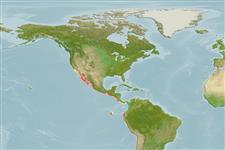Elasmobranchii (sharks and rays) >
Rhinopristiformes (Shovelnose rays) >
Rhinobatidae (Guitarfishes) > Rhinobatinae
Etymology: Zapteryx: Greek, za = an aumentative particle + Greek, pteryx, wing, fin (Ref. 45335).
Environment / Climate / Range
Ecology
Marine; reef-associated; depth range 1 - 200 m (Ref. 37955), usually 1 - 22 m (Ref. 12951). Subtropical, preferred ?; 35°N - 4°S, 121°W - 80°W
Eastern Pacific: southern California, USA to Peru.
Length at first maturity / Size / Weight / Age
Maturity: Lm ?, range 57 - 77 cm
Max length : 83.0 cm male/unsexed; (Ref. 48844); 97.0 cm (female)
Vertebrae: 149 - 150. Spiral valve count: 8-10. Broad disc is about as wide as it is long; dorsal surface covered with numerous, small to large, scattered, stellate prickles; a single median row of enlarged thorns running along the mid-back; a broad, short snout; small, blunt, pebble like teeth; a dorsal fin that originates closer to the pelvic fin bases than to the caudal fin origin; a thick tail and a moderately large, rounded caudal fin without a distinct lower lobe. Tooth count: 60-75/60-75.
Coloration: The dorsal surface is sandy brown to dark gray, with several prominent black bars, and lighter below with dark spots on the posterior edge of the pectoral fins.
Generally in rocky areas but may also be found on sandy bottoms (Ref. 37955). Reported from tide pools (Ref. 12951). Relatively docile, harmless rays that are easily approached by divers (Ref. 48844). Feeds mainly on mollusks and crustaceans (Ref. 37955). Ovoviviparous (Ref. 50449), with 4 to 11 pups in a litter (Ref. 51576). Seldom buries itself in sand.
Etymology: The genus name comes from the Greek za, meaning intensive, and pteryx, meaning fin, in reference to the vertical fins being larger than those of skates. The species name comes from Latin, meaning made rough, in reference to the numerous stellate prickles on its back. (Ref. 48844).
Exhibit ovoviparity (aplacental viviparity), with embryos feeding initially on yolk, then receiving additional nourishment from the mother by indirect absorption of uterine fluid enriched with mucus, fat or protein through specialised structures (Ref. 50449).
During breeding season, male and female adult schools congregate in shallow areas of bays and lagoons (Ref. 51576). Parturition takes place three to four months after mating, with litters of 4 to 11 pups (Ref. 48844).
Compagno, L.J.V., 1999. Checklist of living elasmobranchs. p. 471-498. In W.C. Hamlett (ed.) Sharks, skates, and rays: the biology of elasmobranch fishes. Johns Hopkins University Press, Maryland. (Ref. 35766)
IUCN Red List Status (Ref. 115185)
CITES (Ref. 94142)
Not Evaluated
Threat to humans
Harmless
Human uses
Fisheries: minor commercial
More information
ReferencesAquacultureAquaculture profileStrainsGeneticsAllele frequenciesHeritabilityDiseasesProcessingMass conversion
Tools
Special reports
Download XML
Internet sources
